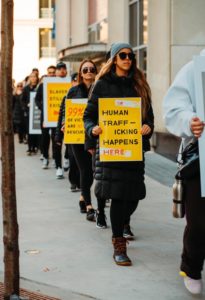Modern slavery is all around us, yet nobody seems to notice.
Commonly misconstrued as being an issue that affects only foreign states, children have been trafficked in and out of every local area in the UK.[1] Due to the closed-door nature of trafficking, identifying the victims of this offence is proving particularly difficult on all levels. The prevalence of trafficking offences and the secretiveness of their operation means that victims are often unidentifiable to both the authorities and ordinary members of the public as the victims often come across just the same as you and me.

Manifestations of modern slavery extend beyond just the images that initially appear in our minds of sexual exploitation. Instead, the reality covers far more than this. Trafficked individuals are indeed forced into the commercial sex industry, but they are also the victims of forced and bonded labour, forced marriages and domestic servitude. They are our cleaners, our beauticians and the children who run down our streets.
How does modern slavery come about?
Modern slavery is the result of a number of different means of coercion. For a large number of victims, they have been trafficked overseas with the promise of a better life in the western world. When they arrive in the UK, they are then forced into low and no pay jobs, with no ability to escape. For some, they have had their passport confiscated leaving them with no way to get out. For others, they are afraid of the illegal nature of their entry into the country. For many, they have been made to think that they are indebted to their perpetrator for alleged kindnesses or drug supplies. Whatever method they use, the trafficker invariably has a hold over them making them certain that they cannot leave. However, this can also happen to British nationals who are largely coerced online through the promise of work or a brighter future either within the UK or through exciting opportunities abroad such as on yachts, luxury islands or party destinations. The result of this is often forced labour – whether it be manual labour, drugs trafficking and county lines offences (which involve the illegal trafficking drugs over county borders) or non-consensual work in the commercial sex industry.
What amounts to modern slavery?
It has been estimated by Unseen (a UK-based organisation helping victims of modern slavery) that we each depend on 40-60 modern slaves to facilitate our lifestyles.
It has been estimated by Unseen (a UK-based organisation helping victims of modern slavery) that we each depend on 40-60 modern slaves to facilitate our lifestyles. [2] This could be directly through those who paint our nails or wash our cars, or indirectly from members of a supply chain who work for less than minimum wage and in fear of never having their passport returned. The coercive and at times violent nature of their perpetrators make it hard for them to communicate and show the reality of their lives, making it all the more difficult to identify who is fighting such a traumatic and thankless battle. Often having been made to feel indebted to their perpetrator, these individuals are too afraid make the reality of their struggles known.
In fact, it is possible that the individuals involved do not even know that they are victims of modern slavery at all. The year 2020, among many things, saw a rise in criticisms of the fast fashion industry. What have been labelled as ‘sweatshop’ factories both in and outside of the UK have recently been put under further scrutiny following allegations that fashion company Boohoo have not been paying their factory staff the national minimum wage.
Staff at these kinds of factories are expected to work long hours, with little pay and in undesirable working conditions to the extent that it could amount to modern slavery. However, the staff might not even be aware of this due to coercion, desperation, or language barriers. This begs the question: what can we do for the best?
An ongoing dilemma is whether it would be for the best to boycott these companies or not. Boycotting would convey the message that this treatment is unacceptable. However, it also runs the risk of putting these people out of work entirely, meaning that they might find themselves jobless or homeless. It is difficult to strike a balance between protecting these victims by campaigning for their welfare, and depriving them of work entirely.
However, despite this difficulty, it is necessary to use our discretion and determine what is right in each situation. We must exercise due diligence and conclude that not all services should be treated the same; we cannot respond to large companies and small businesses in the same way. Where boycotting a fashion giant would send a message rather than shutting it down, boycotting a local business could do more damage than good and leave victims in a potentially worse position.
It is consequently essential that we learn when it is best to boycott, or when it might be better just to offer a friendly face for victims, if they offer it, to open up to.
Modern Slavery and Human Rights
Where the work that they are forced to do is illegal, victims can be seen and treated by the law as criminals. However, progress in this area is being made and the Courts are beginning to acknowledge the insufficient way in which we identify victims of trafficking and the consequent handling of its victims.
The European Court of Human Rights in the recent case of VCL and AN v United Kingdom[3] broadened the duty of public authorities to determine whether an individual is a victim of trafficking before prosecuting them for criminal offences; particularly when there is evidence to suggest that there might be.
When two young people from Vietnam were prosecuted after being forced to work on a cannabis farm, it was deemed a violation of Articles 4 and 6 of the European Convention on Human Rights (Prohibition of slavery and forced labour and the Right to a fair trial respectively) when there was a lack of investigation into their status.
This identification procedure is essential for ensuring that we are not only protecting the victims of trafficking from prosecution, but it will more broadly spur on the movement to easier identification of victims as a whole. If authorities are encouraged to investigate potential victims of trafficking before initiating criminal proceedings, they will be more aware of what signs to look out for. As a result, they will be more effective at spotting these signs within those who initially appear to be ordinary members of the public.

How to spot a victim of trafficking
As with any crime, no one victim is the same. Some individuals might be easy to spot, others might have learned to conceal their struggles to the point that they seem like a safe and ordinary member of society. Signs might manifest in a variety of ways, with some victims displaying all of them and others expressing none. However, generally speaking, the Met Police recommend looking out for people who:[4]
- Look unkempt, injured or malnourished
- Seem anxious or are unable to make eye contact
- Work long and unscheduled hours
- Have unsuitable clothing
- Live in an overcrowded area, or always keep their windows and curtains closed
- Seem to not control their own finances, almost as though they have no access to their own money or property
Although there has been clear progress for the relationship between human rights and human trafficking, there is more that can be done. Authorities need to adjust their approach to identifying and giving aid to victims of trafficking. It is essential to ensure that they are swiftly and safely identified and protected, rather than allowing them to run the risk of prosecution for actions that they had little to no choice in. Beyond this, it is crucial that the public as a whole is more aware of what to look out for. If there is any doubt about the security of an individual, it is never better to stay silent.
If you or somebody you know needs help:
- Modern Slavery Helpline: https://www.modernslaveryhelpline.org/ – 08000 121 700
- CrimeStoppers (anonymous reporting): https://crimestoppers-uk.org/ – 0800 555 111
- The Salvation Army: https://www.salvationarmy.org.uk/modern-slavery – 0800 808 3733
- Non-Emergency Police Contact Number: 101
[1] ‘Slavery in the UK’ (Anti-Slavery) https://www.antislavery.org/slavery-today/slavery-uk/ accessed 26/02/2021.
[2] Unseen Team, ‘How Data, Collaboration and Awareness Can End Modern Slavery Forever’ (Unseen, 10 May 2019) https://www.unseenuk.org/blog/how-data-collaboration-and-awareness-can-end-modern-slavery-forever accessed 26/02/2021.
[3] VCL and AN v United Kingdom Applications Nos 77587/12 and 74603/12 (ECHR, 16 February 2021) Judgement available at: https://hudoc.echr.coe.int/fre#{%22itemid%22:[%22001-207927%22]} .
[4] ‘Modern Slavery’ (Metropolitan Police) https://www.met.police.uk/advice/advice-and-information/ms/modern-slavery/ accessed 15 March 2021.
Written by Millie-Rose Wells
